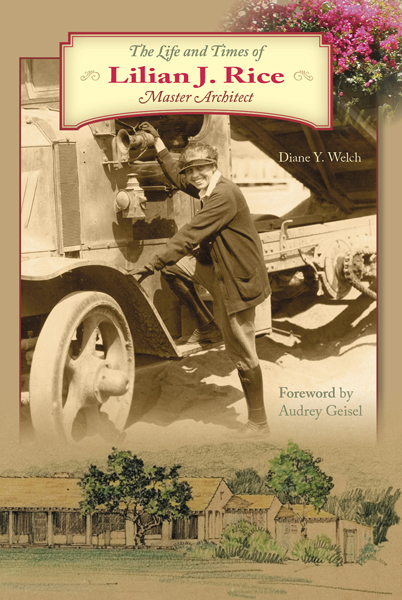|
Diane Y. Welch, our gracious emcee at last month's People in Preservation Awards ceremony, is the leading expert on Rancho Santa Fe architect Lilian J. Rice. We have autographed copies of her second book on Rice in the Marston House Museum Shop. In a glowing review of The Life and Times of Lilian J. Rice, Bobbie Bagel writes of Diane, "With a crusader's determination, she has been shining a steady spotlight on Rice." Read the review here below.
The Life and Times of Lilian J. Rice
Reviewed by Bobbie Bagel
June 2016
 Hard cover - 192 pages
94 color and b/w images, and index
$34.99 - 10% discount to SOHO members |
Why Lilian Jennette Rice never became a household name in San Diego is a mystery! She should be considered with other leading historic figures like Kate Sessions, Irving Gill, and George Marston. In fact, Audrey Geisel, philanthropist and Dr. Seuss’s widow, writes in her foreword to Diane Y. Welch’s newest book, “Rice should be placed right along side Amelia Earhart and Georgia O’Keefe in national prominence!”
Born into a prominent National City family in 1889, Rice graduated from the architecture program at the University of California at Berkeley in 1910—no small feat for a woman in that day. She went on to become a brilliant master architect and educator with 11 fine buildings—all in Rancho Santa Fe—listed on the National Register of Historic Places. And still people wonder, who was this remarkable woman?
Enter Solana Beach-based author Diane Y. Welch. With a crusader’s determination, she has been shining a steady spotlight on Rice. In 2010, Welch came out with her first book, Lilian J. Rice, Architect of Rancho Santa Fe, California. Published by Schiffer, it is a beautiful coffee table edition with hundreds of full-color and sepia-tone photographs as well as architectural renderings and floor plans. They capture Rice’s unique design sensibility for interiors and exteriors in that green haven shaded by eucalyptus groves. Low-slung, single-story adobe or stucco structures with deep-set windows and heavily beamed ceilings were her trademarks, culminating in a Spanish rustic style with strong Arts & Crafts overtones.
Now Welch has published a companion volume called The Life and Times of Lilian J. Rice (Schiffer, 2015, $34.99). The cover features a vintage photo of the feisty subject dressed in work clothes and high boots climbing into a huge dump truck. The shot was taken in 1923 at a Rancho Santa Fe building site where Rice and three female colleagues replaced disgruntled male drivers during their work stoppage. This photo sets the tone for what is to come—the story of plucky, independent, vigorous professional woman.
In this book, Welch trades her usual journalistic style for a first-person narrative. The reader travels with the author as she drives through National City, to the Bay Area, and back to Rancho Santa Fe on fact-finding missions and interviews with dozens of people who have first-hand knowledge of Rice’s life and career. Unfortunately, with the exception of a few renderings, blueprints and vintage photographs, scant documentation of Rice’s work still exists.
Throughout the book, Welch weaves historical events into her narrative—the break up of the old Californio land grants, the 1906 San Francisco earthquake, the 1915 California-Panama Exposition in San Diego. She also presents biographical sketches of Rice’s colleagues, clients and a cache of celebrities, who found bucolic Rancho Santa Fe a welcome respite from Hollywood.
Architecture fans, who may have read Welch’s first book or are already familiar with Rice’s work, will be interested in the new book’s deeper look at role models who helped shape the architect’s distinctive style. They include Rice’s mother, an accomplished landscape painter and interior designer; the esteemed Arts & Crafts architect Bernard Maybeck, her Berkeley professor; and Hazel Waterman, San Diego’s first woman architect whose painstaking restoration of the Casa de Estudillo in Old Town was an inspiration to Rice and relevant to her own adobe projects.
In 1925, the intrepid Rice also followed in the footsteps of her employer, architect Richard Requa, when she traveled alone to Spain and Cuba, seeking design inspiration for Rancho Santa Fe architecture. She took hundreds of photos of rustic buildings and details with her trusty box camera. (Welch addresses a lingering controversy over whether Requa or Rice designed the town’s core buildings in a compelling chapter titled “Lilian Rice: Liar or Cheat?”)
Sadly, in 1938, Lilian J. Rice died at the age of 49 from a ruptured appendix with complications from ovarian cancer. Her legacy to Rancho Santa Fe and San Diego is immense. Just last month, the city of San Diego’s historical review board designated as a historic site a home at 2324 Pine Street in Mission Hills, which, according to Diane’s first book, Rice may have designed in 1931. Hampered by the architect’s few surviving records, there’s still more to learn about Lilian.
|
2025
2024
2023
2022
2021
2020
2019
2018
2017
2016
2015
|




